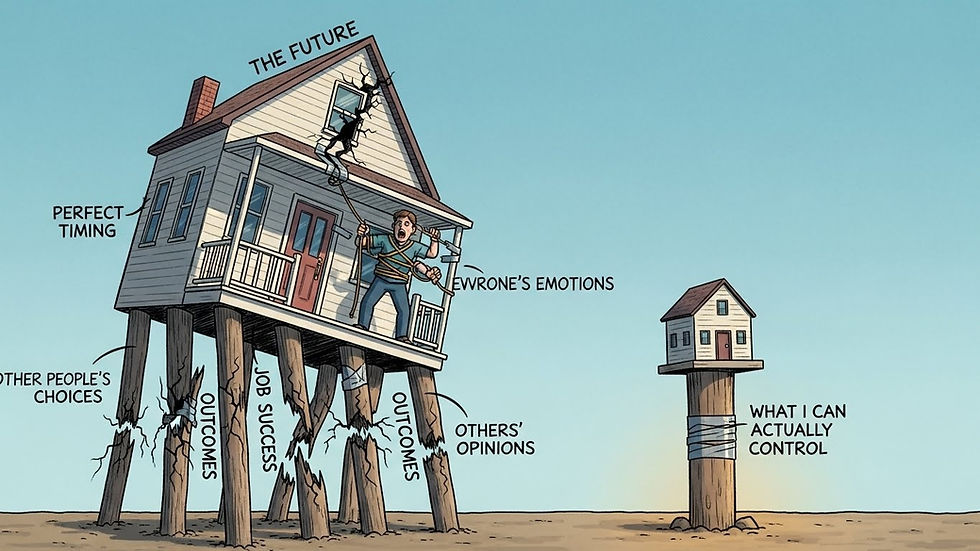🧠 Adult ADHD Mythbusters: When "Squirrel Brain" Might Be Something Else Entirely
- Natasha Bussey
- May 6
- 4 min read

Ever catch yourself saying "I'm so ADHD!" after losing your keys for the 17th time this week? Or scrolling TikTok and suddenly self-diagnosing based on that weirdly specific video that just described your entire life? 👀
Let's talk ADHD reality checks, friends – because while adult ADHD is absolutely real (affecting ~4.4% of adults worldwide[1]), that forgetfulness might be something else entirely!
ADHD Myth-Smashing Time! 💥
MYTH: "ADHD is just a childhood thing" REALITY: Research shows ADHD can persist into adulthood in up to 65% of cases[2]. But the symptoms often change! Childhood hyperactivity often transforms into internal restlessness or decision-making impulsivity. It doesn't magically disappear after high school graduation!
MYTH: "Everyone's a little ADHD these days" REALITY: While attention challenges are universal human experiences, clinical ADHD involves specific neural differences visible on brain scans[3]. It's like saying "everyone gets sad" versus clinical depression – the difference is in severity, persistence, and neurobiological basis.
MYTH: "If I can focus on video games, I can't have ADHD" REALITY: ADHD often involves interest-based attention regulation, not a total inability to focus. Many people with ADHD can hyperfocus on high-stimulation activities while struggling with everyday tasks[4]. It's about inconsistent attention, not absent attention!
The Symptom Imposters: When It Looks Like ADHD But Isn't 🕵️
Before self-diagnosing, consider these common ADHD "lookalikes":
Anxiety Disorders: Racing thoughts, concentration issues, and restlessness can mirror ADHD symptoms. Research shows up to 50% of adults seeking ADHD assessment actually have anxiety disorders[5].
Sleep Deprivation: Chronically getting <7 hours creates attention deficits nearly indistinguishable from ADHD on cognitive tests[6]. Yes, your phone addiction might be making you THINK you have ADHD!
Depression: The cognitive symptoms of depression (brain fog, difficulty concentrating) frequently masquerade as ADHD. Studies show 20-30% of people with depression get misdiagnosed with ADHD initially[7].
Thyroid Issues: Hyperthyroidism can cause hyperactivity, while hypothyroidism often causes brain fog and concentration problems[8].
Trauma Response: Hypervigilance from PTSD creates attention difficulties as the brain constantly scans for threats rather than focusing on tasks[9].
Whether It's ADHD or Something Else – Strategy Time! 🛠️
Regardless of diagnostic status, these evidence-based approaches can help manage attention challenges:
Environmental engineering: Research shows external structure dramatically improves function. Try body-doubling (working alongside someone), visual timers, and reducing transition points in your day[10].
Exercise before focus work: Just 20 minutes of moderate exercise improves executive function for 2-3 hours by boosting dopamine and norepinephrine – the exact neurotransmitters targeted by ADHD medications[11].
Pomodoro technique: The 25-minute work/5-minute break method aligns perfectly with attention span research showing most brains need reset points every 25-45 minutes[12].
Sleep hygiene overhaul: Prioritizing 7-9 hours of quality sleep improves attention by up to 44% according to research at UC Berkeley[13].
Notification detox: Each notification interruption costs about 23 minutes of refocusing time. Silencing non-urgent alerts can reclaim hours of productivity[14].
The Professional Approach 👩⚕️👨⚕️
While self-help strategies are valuable, professional assessment provides clarity and opens doors to evidence-based treatments:
Comprehensive evaluation: A proper ADHD assessment involves multiple data points - not just a quick questionnaire.
Personalized treatment: From cognitive-behavioral approaches to medication options, treatment should be tailored to your specific needs.
Addressing comorbidities: Over 60% of adults with ADHD have at least one additional condition that needs concurrent treatment[15].
Ready for Clarity? 🌈
If attention challenges are disrupting your life, I'm here to help navigate diagnosis, treatment options, and practical coping strategies. Professional counseling can provide the structure and accountability to implement lasting changes, whether you're dealing with ADHD or its many "imposters."
Reach out today to schedule a consultation – because your brain deserves to work with you, not against you! Let's untangle what's really happening and create strategies tailored specifically to YOUR neurology.
-----------
References:
Fayyad J, et al. (2017). The descriptive epidemiology of DSM-IV Adult ADHD in the World Health Organization World Mental Health Surveys. ADHD Attention Deficit and Hyperactivity Disorders, 9(1), 47-65.
Faraone SV, et al. (2021). The World Federation of ADHD International Consensus Statement: 208 Evidence-based conclusions about the disorder. Neuroscience & Biobehavioral Reviews, 128, 789-818.
Hoogman M, et al. (2019). Brain Imaging of the Cortex in ADHD: A Coordinated Analysis of Large-Scale Clinical and Population-Based Samples. American Journal of Psychiatry, 176(7), 531-542.
Ozel-Kizil ET, et al. (2016). Adult ADHD and the importance of hyperfocus: A qualitative study. ADHD Attention Deficit and Hyperactivity Disorders, 8(1), 8-16.
Solberg BS, et al. (2019). Comorbidity between ADHD and anxiety disorders across the lifespan. Journal of Attention Disorders, 23(9), 1007-1017.
Krause AJ, et al. (2017). The sleep-deprived human brain. Nature Reviews Neuroscience, 18(7), 404-418.
McIntosh D, et al. (2009). Depression and ADHD in adult outpatients: Is there an association? Journal of Attention Disorders, 13(1), 97-104.
Chaker L, et al. (2017). Thyroid function and cognitive decline in the general population. Journal of Clinical Endocrinology & Metabolism, 102(7), 2581-2591.
Antshel KM, et al. (2013). Posttraumatic stress disorder in adult attention-deficit/hyperactivity disorder: Clinical features and familial transmission. Journal of Clinical Psychiatry, 74(3), e197-e204.
Sibley MH, et al. (2016). Organization interventions for adults with ADHD. Journal of Attention Disorders, 20(7), 551-561.
Ludyga S, et al. (2016). Acute effects of moderate aerobic exercise on specific aspects of executive function in different age groups: A meta-analysis. Psychophysiology, 53(11), 1611-1626.
Cirillo F. (2018). The Pomodoro Technique: The Life-Changing Time-Management System. Virgin Books.
Walker MP. (2017). Why We Sleep: Unlocking the Power of Sleep and Dreams. Scribner.
Mark G, et al. (2016). Neurotics can't focus: An in situ study of online multitasking in the workplace. Proceedings of the 2016 CHI Conference on Human Factors in Computing Systems, 1739-1744.
Katzman MA, et al. (2017). Adult ADHD and comorbid disorders: Clinical implications of a dimensional approach. BMC Psychiatry, 17(1), 302.




Comments